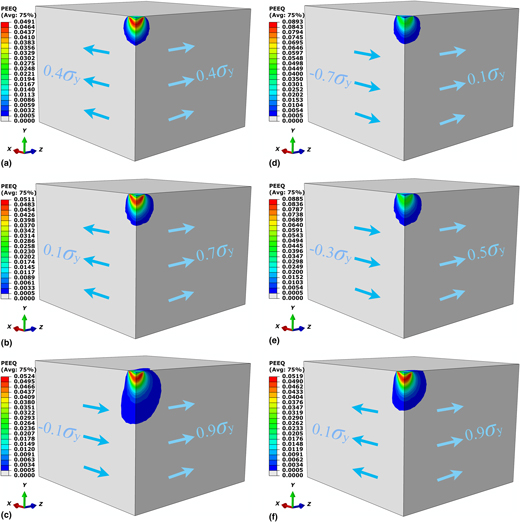Crossref Citations
This article has been cited by the following publications. This list is generated based on data provided by
Crossref.
Feng, Biao
and
Liu, Zhen
2019.
Finite element modeling and simulations on indentation and scratch tests on thin films: effects of prestress.
MRS Communications,
Vol. 9,
Issue. 2,
p.
756.
Peng, Guangjian
Xu, Fenglei
Chen, Jianfeng
Hu, Yahao
Wang, Huadong
and
Zhang, Taihua
2020.
A cost-effective voice coil motor-based portable micro-indentation device for in situ testing.
Measurement,
Vol. 165,
Issue. ,
p.
108105.
Moharrami, R.
and
Sanayei, M.
2020.
Developing a method in measuring residual stress on steel alloys by instrumented indentation technique.
Measurement,
Vol. 158,
Issue. ,
p.
107718.
Peng, Guangjian
Xu, Fenglei
Chen, Jianfeng
Wang, Huadong
Hu, Jiangjiang
and
Zhang, Taihua
2020.
Evaluation of Non-Equibiaxial Residual Stresses in Metallic Materials via Instrumented Spherical Indentation.
Metals,
Vol. 10,
Issue. 4,
p.
440.
Zhang, Tairui
Guo, Jianzhang
and
Wang, Weiqiang
2021.
A strain-pattern-based spherical indentation method for simultaneous uniaxial tensile residual stress and flow property determination.
The Journal of Strain Analysis for Engineering Design,
Vol. 56,
Issue. 1,
p.
50.
Clyne, Trevor William
Campbell, Jimmy Edward
Burley, Max
and
Dean, James
2021.
Profilometry‐Based Inverse Finite Element Method Indentation Plastometry.
Advanced Engineering Materials,
Vol. 23,
Issue. 9,
Jeong, Chanyoung
Hwang, Yewon
Kim, Naksoo
Lee, Cheolsoo
and
Lee, Hyungyil
2021.
Evaluation of equi-biaxial residual stress from spherical indentation imprint.
International Journal of Mechanical Sciences,
Vol. 211,
Issue. ,
p.
106773.
2021.
Testing of the Plastic Deformation of Metals.
p.
148.
Burley, Max
Campbell, Jimmy E
Reiff-Musgrove, Rebecca
Dean, James
and
Clyne, Trevor William
2021.
The Effect of Residual Stresses on Stress–Strain Curves Obtained via Profilometry‐Based Inverse Finite Element Method Indentation Plastometry.
Advanced Engineering Materials,
Vol. 23,
Issue. 5,
Greco, Alessia
Sgambitterra, Emanuele
and
Furgiuele, Franco
2021.
A new methodology for measuring residual stress using a modified Berkovich nano-indenter.
International Journal of Mechanical Sciences,
Vol. 207,
Issue. ,
p.
106662.
Zhao, Siwei
Zhang, Jianwei
Li, Yuanxin
Liu, Haitao
Wang, Bingbing
and
Zhao, Minghao
2022.
An indentation method for determining the film thickness, Young’s modulus, and hardness of bilayer materials.
Journal of Physics D: Applied Physics,
Vol. 55,
Issue. 27,
p.
274002.
Peng, Wei
Jiang, Wenchun
Sun, Guanghua
Yang, Bin
Shao, Xiaoming
and
Tu, Shan-Tung
2022.
Biaxial residual stress measurement by indentation energy difference method: Theoretical and experimental study.
International Journal of Pressure Vessels and Piping,
Vol. 195,
Issue. ,
p.
104573.
Jasim, Saade Abdalkareem
Ali, Muneam Hussein
Mahmood, Zaid Hameed
Rudiansyah, Mohammad
Alsultany, Forat H.
Mustafa, Yasser Fakri
Ramadan, Montather F.
and
Surendar, Aravindhan
2022.
Role of Alloying Composition on Mechanical Properties of CuZr Metallic Glasses During the Nanoindentation Process.
Metals and Materials International,
Vol. 28,
Issue. 9,
p.
2075.
Kong, Desheng
Yang, Bin
and
Hu, Peiyu
2022.
Binary Newton Calculation Method of Residual Stress Based on the Indentation Energy Difference Theory.
Metals,
Vol. 12,
Issue. 9,
p.
1439.
Xue, He
Yang, Yong-Jie
Zhang, Shun
Zhang, Yu-Biao
Shi, Zhe-Ren
Wang, Zheng
and
Zhang, Jia-Qing
2023.
Determination of residual stresses in metallic materials based on spherical indentation strain.
Materials Testing,
Vol. 65,
Issue. 7,
p.
982.
LI, SaiFei
ZHANG, Liang
PENG, GuangJian
HAN, Zhi
and
ZHANG, TaiHua
2023.
Evaluation of equibiaxial residual stress in metallic materials using the loading work of instrumented sharp indentation.
SCIENTIA SINICA Physica, Mechanica & Astronomica,
Vol. 53,
Issue. 1,
p.
214603.
Luo, Sangyu
Huang, Ruizhe
Bai, Haoran
Jiang, Peng
Qu, Zhaoliang
and
Fang, Daining
2024.
Interfacial failure behavior of Thermal Barrier Coatings (TBCs) at high temperatures: An in-situ indentation study based on X-ray imaging.
Journal of the Mechanics and Physics of Solids,
Vol. 187,
Issue. ,
p.
105647.
Luo, Sangyu
Huang, Ruizhe
Bai, Haoran
Xu, Baosheng
and
Qu, Zhaoliang
2024.
An indentation-based method for characterization of non-uniform triaxial residual stress in curved thermal barrier coating.
Measurement,
Vol. 232,
Issue. ,
p.
114671.





